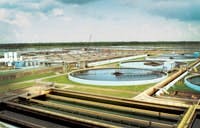The East Bank Wastewater Treatment Plant (EBWWTP) in New Orleans has weathered its fair share of challenges. Some of the most obvious were the damages sustained as a result of Hurricane Katrina, which pushed a wall of water in front of it that submerged everything in its path. The plant is protected with a 14-ft berm around the facility, but was hit with an 18-ft wave on the morning of Aug. 29, 2005. That wave completely inundated the plant and left it submerged for weeks. Staff in the facility were rescued by helicopter several days later.
Despite more than $70 million in sustained damages to the plant, and despite being submerged for weeks, primary clarification was restored within six weeks of Katrina and secondary treatment was restored four weeks later. But the memory looms large and is still evident all these years later, as WEFTEC.14 facility tour attendees will be able to note this fall when they visit the plant.
“To this day, driving through the East Bank Facility’s adjoining neighborhoods, the impact of Hurricanes Katrina and Rita is still evident,” said Don Patterson, senior project manager for Veolia North America, which operates and maintains the plant. “A unique design, the East Bank Treatment Plant sits in a basin, which, during Katrina, was completely submerged under 22 ft of floodwaters.”
EBWWTP originally was constructed in 1973 and upgraded in 1980 from a 23 million-gal-per-day (mgd) facility to a 122-mgd pure oxygen-activated sludge wastewater treatment plant that serves the entire East Bank of Orleans Parish. Treated effluent from the plant is discharged to the Mississippi River via two 60-mgd and three 30-mgd pumps.
Plant Landscape
Located on the East Bank of the Mississippi River in Orleans Parish, the facility is close to the St. Bernard Parish line and an abandoned landfill to the east. It also is surrounded by undeveloped wetlands on the north and west sides. A residential neighborhood lies to the south.
The only entrance road into the plant is from the south; however, emergency exits leading over the levee exist at each of the cardinal compass points. Plant access is monitored and restricted by security guards and a closed-circuit camera system. The EBWWTP, under normal operations, facilitates the removal of sludge material by incineration. For backup purposes, the plant is equipped with mechanisms for sludge removal by landfill disposal.
Facility Processes
Three sewerage force mains discharge into the plant’s headworks for preliminary treatment. The headworks comprises six mechanical bar screens and six aerated grit chambers.
From the headworks, incoming flow travels down an aerated influent channel to provide oxygen for the incoming wastes. The return activated sludge (RAS) lines are connected to the influent channel to provide the proper mixing and concentration of microorganisms entering secondary treatment.
While the resulting biological sludge is removed in the secondary clarifiers, the gaseous product (carbon dioxide) escapes the system as an off gas. The plant is equipped with four oxygen reactors.
The pure oxygen is trucked into the facility and stored as a liquid in a 45,000-gal liquid oxygen tank. An ambient vaporizer then converts the liquid into its gaseous state for use in the oxygen reactor. Following the oxygen reactors, flow enters one of the seven available clarifiers.
Ten 150-hp, 8-mgd vertical turbine RAS pumps remove the settled sludge from the bottom of the clarifiers and transport it to either the influent channel or Clarifier 4, which serves as the plant thickener mechanism. From Clarifier 4 the thickened sludge is transported to the belt press via a 1,000-gpm waste activated sludge pump.
Four 2-meter Andritz belt presses further condense the sludge from an approximately 4% solid material to a 20% to 22% material capable of disposal by incineration or by trucking to a landfill.
Moving Forward
The motto of the facility seems to be to continue rebuilding.
“Since 2006, the Sewerage & Water Board of New Orleans with Veolia has completed and continues some $47 million in hurricane recovery and capital improvements to restore the East Bank plant,” Patterson said. “And, like the resiliency of the neighborhoods, rebuilding continues.”
Download: Here


